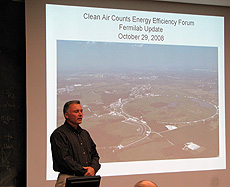Fermilab holds energy-saving seminar for mayors

FESS head Randy Ortgiesen gave a talk at the Clean Air Counts seminar for the Metropolitan Mayors Caucus held at Fermilab on Oct. 29.
A few dozen representatives for local mayoral offices gathered at Fermilab last month to learn energy saving measures and strategies from the laboratory and industry experts.
Fermilab has decreased its energy consumption in non-scientific facilities by 13.2 percent since 2003, and plans to reach a 30 percent reduction by 2015.
"We wanted to enlighten folks from different municipalities on what the federal sector is doing and what initiatives we are pursuing," said environmental officer Eric Mieland. "We can lead by example and try to influence the private sector to take measures to conserve energy."
The Clean Air Counts seminar for the Metropolitan Mayors Caucus held at Fermilab last month gave Facilities and Engineering Services Section head Randy Ortgiesen a chance to present on Fermilab's energy consumption, challenges and energy saving plans for the future.
"Anytime you can hear what anyone is doing, it is beneficial," said Dan Lutzenkirchen, a facility manager for DuPage County.
Lutzenkirchen and Dan Baran, who works in a DuPage County power plant, both attended the meeting and visited Fermilab for the first time. They came to gather information, particularly from a larger-scale facility, that they could take back to their institutions.
In FY07, Fermilab consumed enough energy to power 45,000 homes for that year. Although Fermilab has already decreased its energy consumption, the laboratory will need to apply further reduction strategies in the coming years. The laboratory's 30 percent reduction goal from a 2003 baseline is part of the Department of Energy's Transformational Energy Action Management (TEAM) initiative.
"We'll need to support more scientific achievements with less energy consumption in non-scientific facilities," Ortgiesen said.
To meet the TEAM goals, which include energy and water reduction as well as renewable fuels, energy and sustainability goals, Ortgiesen said that the laboratory will need to employ a plan. It will consist of facility consolidation, environmental and energy-efficient upgrades and building designs that meet green standards.
Eve Pytel, assistant director for Clean Air Counts within the Metropolitan Mayors Caucus, said the group chose Fermilab to learn about what a federal and large-scale facility does to manage energy. Fermilab was also one of the first members of the Clean Air Counts organization.
--Rhianna Wisniewski
|